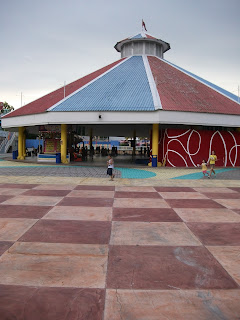Mrupupup saw this in someone's email and found it was informative. Never knew of the pictures behind China's Renminbi notes. Ok, just to share and hope you find the information interesting. China is a fascinating country with a wide and varied landscape, do visit this country in your life time. Mrupupup has visited China a few times.
Banknotes are known as “national name card.” and RMB (or Renminbi) is China`s name card. Currently China have issued a total of five sets of RMB. Do you want to know what sceneries are found on the back of the notes?
Below is a list of these places on the back of different version of RMB :
1. The back of 100 Yuan RMB (The third version of the first set RMB) – Longevity Hill in Summer Palace

Longevity Hill is a 60-meter-high hill in the gardens of the Summer Palace in Beijing, China. Together with Kunming Lake, it shapes the basic layout of the imperial garden’s landscape.
2. The back of 100 Yuan RMB (The fifth version of the first set RMB) – Beihai Park.

Beihai Park (located in Beijing) is the oldest imperial garden in the world as well as one of the largest in China. This huge imperial garden has a history of over 1,000 years. Originally built during Liao Dynasty (916 – 1125AD).
3. The back of 2 Yuan RMB (The second set RMB) – Yan`an Pagoda Hill


Pagoda Hill is located by the Yanhe River, east of Yan’an. The pavilion-style pagoda, built during the Ming Dynasty (1368-1644), is 44 meters high with nine stories. Standing on top of the majestic pagoda, you can have a whole view of Yan’an City. The pagoda is the symbol of Yan’an as a sacred place in the Chinese revolution.
4. The back of 3 Yuan RMB (The second set RMB) – Longyuankou Stone Bridge in Jingang Mountain


The Longyuankou Stone Bridge is located at the foot of The Jinggang Mountains, where the first big battle victory of Red Army took place. Jingang Mountain is known as the “cradle of the Chinese revolution.” It is located on the common boundary of Jiangxi Province and Hunan Province, 352 kilometers southwest from the capital city – Nanchang.
5. The back of 1 Yuan RMB (The fourth set RMB) – Badaling Great Wall


Badaling Great Wall is the site of the most visited section of the Great Wall of China, approximately 70 kilometers northwest of Beijing.
6. The back of 2 Yuan RMB (The fourth set RMB) – Nantian Yizhu


Nantian Yizhu (the Pillar of Southern Heaven) is located in Tianya Haijiao (end of sky and the corner of the sea) scenery district, located at southwest seaside of Sanya city, Hainan Island.
7. The back of 5 Yuan RMB (The fourth set RMB) – Wu Gorge


Wu Gorge is the second gorge of the Three Gorges system on the Yangtze River. Wu Gorge starts from the Port of Daning River, Wushan Counry, Chongqing city in the west and ends at the Guandu port of Badong County, Hubei Province in the east, which is zigzagging more than forty km in the Yangtze River.
8. The back of 10 Yuan RMB (The fourth set RMB China) – Mount Everest


Mount Everest is the Earth’s highest mountain, with a peak at 8,848 metres above sea level. It is located in the Mahalangur section of the Himalayas. The international border between China and Nepal runs across the precise summit point.
9. The back of 50 Yuan RMB (The fourth set RMB China) – Hukou Waterfall


The Hukou Waterfall, the largest waterfall on the Yellow River, China, the second largest waterfall in China, is located at the intersection of Shanxi Province and Shaanxi Province, 165 km to the west of Fenxi City.
10. The back of 100 Yuan RMB (The fourth set RMB China) – Jingang Mountain


The Jinggang Mountains, known as the “cradle of the Chinese revolution. It is located in the Luoxiao Mountains, in the remote border region between Jiangxi and Hunan provinces, China.
11. The back of 1 Yuan RMB (The fifth set RMB China) – Three Ponds Mirroring the Moon in Hangzhou


Three Ponds Mirroring the Moon is one of the “10 Scenic Spots in West Lake”. On the night of the Mid-Autumn festival, when the moon shines full and bright in the sky, a candle is lit inside each of the pagodas. The light from the holes and the moon cast their reflections on the water, hence the name.
12. The back of 5 Yuan RMB (The fifth set RMB China) – Mountain Tai


Tai Shan (or Mountain Tai) is one of the five Daoist sacred mountains in China. Because of its history it is the most climbed mountain in China. It is located in the north of Tai’an city, in the middle of Shandong province.
13. The back of 10 Yuan RMB (The fifth set RMB China) – Kuimen Gate


Kuimen, or Kui Gate, is also known as Qutang Pass, the door for Three Gorges. Here the river is flanked by sheer cliffs on both sides. It is the gate through which the Yangtze River flows into the Three Gorges from the Sichuan Basin.
14. The back of 20 Yuan RMB (The fifth set RMB China) – Li River in Guilin


Li River is the biggest and the most beautiful Karst landscape. The magnificent scenery of the Li River is printed on the back of the 20 CNY note. It is a known as a pearl of China and the essence of Gulin. Li River is famous as the city’s soul and heart.
15. The back of 50 Yuan RMB (The fifth set RMB China) – Potala Palace


The Potala Palace is located in Lhasa, Tibet. It was named after Mount Potala, an important mountain in Buddhist traditions. The general structure of the Potala Palace is broken into two parts; the Red Palace and the White Palace.





























Comments
Post a Comment